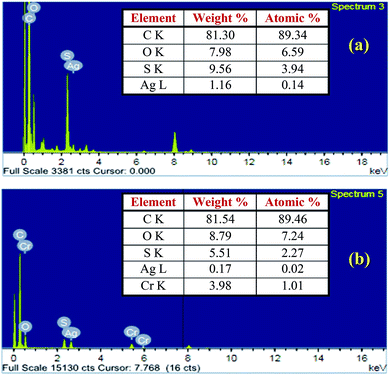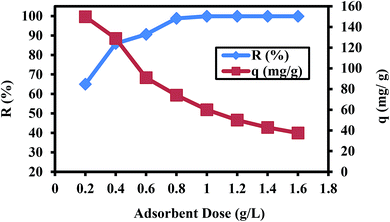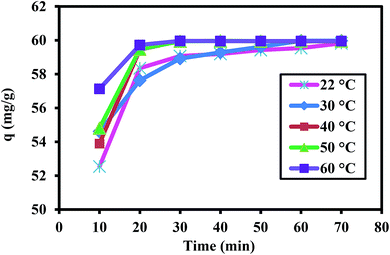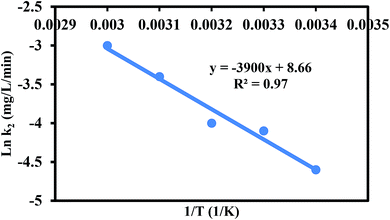 Open Access Article
Open Access ArticleCreative Commons Attribution 3.0 Unported Licence
The development of a ternary nanocomposite for the removal of Cr(VI) ions from aqueous solutions
Azza Shokry *a,
Ayman El Tahanb,
Hesham Ibrahima,
Moataz Solimanc and
Shaker Ebrahimc
*a,
Ayman El Tahanb,
Hesham Ibrahima,
Moataz Solimanc and
Shaker Ebrahimc
aDepartment of Environmental Studies, Institute of Graduate Studies and Research, Alexandria University, P.O. Box 832 163 Horreya Avenue, El-Shatby, Alexandria, Egypt. E-mail: azzashokry@alexu.edu.eg
bDepartment of Physics, Faculty of Science, Tanta University, P.O. Box 44519, Tanta, Egypt
cDepartment of Materials Science, Institute of Graduate Studies and Research, Alexandria University, P.O. Box 832, Alexandria, Egypt
First published on 28th November 2019
Abstract
The aim of this study is to develop a ternary nanocomposite (NC) of polyaniline (PANI)/2-acrylamido-2-methylpropanesulfonic acid (AMPSA)-capped silver nanoparticles (NPs)/graphene oxide quantum dots (PANI/Ag (AMPSA)/GO QDs) as an efficient adsorbent for the removal of the highly toxic hexavalent chromium (Cr(VI)) from polluted water. PANI/Ag (AMPSA)/GO QDs NC was synthesized via in situ oxidative polymerization. The effects of pH, adsorbent dose, initial concentration, temperature, contact time, ionic strength and co-existing ions on the removal of Cr(VI) by PANI/Ag (AMPSA)/GO QDs were investigated. The PANI/Ag (AMPSA)/GO QDs NC (25.0 mg) removed 99.9% of Cr(VI) from an aqueous solution containing 60 mg L−1 Cr(VI) ions at pH 2. Energy dispersive X-ray (EDX) and inductively coupled plasma spectrometry (ICP) studies confirmed the adsorption of Cr(VI) and that some of the adsorbed Cr(VI) was reduced to Cr(III). Cr(VI) removal by the PANI/Ag (AMPSA)/GO QDs NC followed the pseudo-second order kinetic model, and the removal was highly selective for Cr(VI) in the presence of other co-existing ions. In summary, the PANI/Ag (AMPSA)/GO QDs NC has potential as a novel adsorbent for Cr(VI).
1. Introduction
The wastewater discharged from different industries such as the textile, tanning, electroplating, metal finishing and stainless steel production industries may contain a level of Cr(VI) higher than the permissible level. High concentrations of Cr(VI) can cause major hazards to human, animals and plants. The permissible limit of Cr(VI) for industrial effluents to be discharged to surface water is 0.1 mg L−1 and for potable water it is 0.05 mg L−1.1Towards this goal, many methods and techniques have been established for removing the highly toxic Cr(VI) from wastewater and reducing Cr(VI) to the less toxic Cr(III) prior to discharge into the environment. These methods include electrochemical methods, membrane filtration, ion exchange, chemical reduction/precipitation and adsorption.2–8 However, their application on a large scale faces many drawbacks such as high cost, complexity, low efficiency and sludge generation.9 On the other hand, owing to the simple procedure, cost-effectiveness, high efficiency, sludge free operation, potential for regeneration and environmental friendliness, the adsorption method has a great potential for the removal of Cr(VI), and thus has been attracting increasing attention in recent years.10
The development of new materials plays an important role by providing new characteristics for remediation/treatment applications. Graphene oxide quantum dots (GO QDs) with a particle size ranging from 2 to 20 nm are attracting considerable attention due to their superior properties such as mechanical stability, large surface area, and tunable electrical and optical properties. They are good candidates for coordinating to other molecules or materials because of important functional groups present on their surface, i.e. hydroxyl, carboxyl and epoxy groups.11,12 In addition, silver nanoparticles (Ag NPs) are anti-microbial, non-toxic, chemically stable and have a high surface-to-volume ratio. Recent advances in the synthesis of Ag NPs have been achieved through various studies related to the use of Ag NPs for the removal of heavy metals and catalysis.13–17
However, nanoparticles and quantum dots are prone to agglomeration, and consequently their capacity and selectivity significantly decrease. Accordingly, the most promising solution is to incorporate these materials into polymeric matrices.18
Polyaniline (PANI) possesses a large amount of amine and imine functional groups, which can interact with metal ions.19–22 PANI has been used for adsorbing different heavy metal ions due to its porous structure, regeneration, non-toxicity, insolubility in water, high stability and low cost.19,20 The incorporation of NPs into PANI does not only solve the agglomeration problem but can also improve the properties of the PANI matrix.18
Herein, we report the synthesis PANI/Ag (AMPSA)/GO QDs NC via an in situ oxidative polymerization method for the efficient removal of Cr(VI) from aqueous solution. Its removal performance for Cr(VI) was investigated using the batch technique under different environmental conditions, such as contact time, ionic strength, pH, and temperature, to explore the possible interaction mechanism.
2. Materials and methods
2.1 Materials
Aniline monomer (99.0%) was obtained from Research Lab, India. Ammonia solution 25% was received from Chem Solute, Germany. D(+)Glucose anhydrous was purchased from BDH Prolabo Chemicals. Hydrochloric acid (36.0%), sodium hydroxide (98.0%), sodium bicarbonate (99.5%) and boric acid (≥99.5%) were purchased from Sigma-Aldrich, USA. Potassium dichromate (99.0%) and sodium borohydride (99.0%) were obtained from Merck, Germany. Ammonium persulfate (APS) (98.0%), ethanol (HPLC grade), copper sulfate pentahydrate (99.0%) and magnesium sulfate heptahydrate (99.0%) were purchased from Fisher Scientific, UK. 2-Acrylamido-2-methylpropanesulfonic acid (AMPSA) (97.0%), magnesium chloride hexahydrate (98.0%) and calcium nitrate tetrahydrate (98.0%) were obtained from Acros Organics, Germany. Anhydrous lead chloride (99.0%) was received from Oxford Laboratory, India. Sodium chloride (99.0%) was received from Honeywell Company, USA. Aluminum chloride hexahydrate (95.0%) and silver nitrate (99.8%) were purchased from PRS Panreac, Spain. Dodecylbenzene sulfonic acid (DBSA) and potassium sulfate (99%) were purchased from El-Gomhoria Chemical Company, Egypt.2.2 Synthesis of DBSA-doped PANI (PANI)
DBSA-doped PANI solution was prepared via chemical oxidative polymerization of aniline14 with some modifications. Aniline monomer (0.03 mL) was dissolved in 10 mL deionized water. 10 mL acidic solution of DBSA (0.3 g) and APS (0.1 g) were then slowly added over 1 h to the aniline solution with continuous stirring at room temperature until the colloidal solution turned dark green. The prepared doped PANI powder was collected by centrifugation at 7000 rpm for 8 min and washed consecutively with ethanol and deionized water. The collected PANI was dried at 60 °C.2.3 Synthesis of AMPSA-capped Ag NPs (Ag (AMPSA))
Ag (AMPSA) NPs were synthesized via the chemical reduction of silver nitrate using sodium borohydride as a reducing agent.23 Freshly prepared 10 mM sodium borohydride (1.2 mL) was added to 36.8 mL of deionized water in an ice bath under continuous stirring. Then, 0.4 mL of 10 mM AgNO3 solution was added dropwise. The color of the solution changed to yellow, indicating the formation of Ag NPs. Finally, 0.3 mL of 10 mM AMPSA as a stabilizing agent was added dropwise to the mixture with continuous stirring for 10 min. Ag (AMPSA) NPs were separated via centrifugation at 8000 rpm for 10 min. The NPs were washed several times using both ethanol and deionized water. Finally, the collected Ag NPs were dried in a vacuum oven at 40 °C.2.4 Synthesis of graphene oxide quantum dots (GO QDs)
GO QDs were prepared directly by glucose pyrolysis. 2 g of glucose was heated to 250 °C and after 5 min, the glucose was changed to the liquid state. The color of this liquid changed from colorless to orange within 20 min. This orange liquid was added dropwise to 100 mL of 12.5% ammonia solution under vigorous stirring. Then the solution was heated at 70 °C for 3 h until the odor of ammonia vanished and the pH was neutralized to 7. The volume of the GO QDs solution was maintained at 50 mL. The GO QD powder was separated by heating and evaporation of the GO QD solution at 200 °C for about 2 h.2.5 Synthesis of PANI/AMPSA-capped Ag (PANI/Ag (AMPSA)) NC
PANI/Ag (AMPSA) NC was prepared via the in situ oxidative polymerization of aniline in the presence of Ag (AMPSA) NPs. Aniline monomer (0.03 mL) was dissolved in 10 mL of previously prepared Ag (AMPSA) NPs. 10 mL acidic solution of DBSA (0.3 g) and APS (0.1 g) were then slowly added to the aniline solution with continuous stirring at room temperature until the colloidal solution turned dark green. The prepared PANI/Ag (AMPSA) NC powder was collected by centrifugation at 7000 rpm for 8 min and washed consecutively with ethanol and deionized water. The collected NC was dried in a vacuum oven at 40 °C.2.6 Synthesis of PANI/GO QDs NC
The nanocomposite of PANI/GO QDs was prepared via the in situ oxidative polymerization of aniline in the presence of GO QDs. 0.03 mL aniline monomer was dissolved in 9 mL deionized water. 1 mL of the previously prepared GO QDs solution was added under vigorous stirring at room temperature for 10 min. Then, 10 mL solution of DBSA (0.3 g) and APS (0.1 g) was slowly added to the aniline and GO QDs solution with continuous stirring at room temperature until a dark green color was observed. The green powder of PANI/GO QDs NC was collected through centrifugation and washing with ethanol and deionized water, then dried in a vacuum oven at 40 °C.2.7 Synthesis of PANI/AMPSA-capped Ag/GO QDs (PANI/Ag (AMPSA)/GO QDs) NC
The PANI/Ag (AMPSA)/GO QDs NC was prepared via the in situ oxidative polymerization of aniline in the presence of freshly prepared Ag (AMPSA) NPs and GO QDs.23 The ternary NC was prepared by mixing 10 mL of AMPSA-capped Ag NPs and 1 mL of the previously prepared GO QDs solution under magnetic stirring for 10 min. Aniline monomer (0.03 mL) was added to the above mixture under continuous stirring for 10 min. 10 mL of DBSA (0.3 g) and APS (0.1 g) aqueous solution was added dropwise with stirring at room temperature until the dark green colored nanocomposite colloid was obtained. The prepared PANI/Ag (AMPSA)/GO QDs NC powder was collected by centrifugation at 7000 rpm for 8 min and washing with ethanol then deionized water. The collected NC was dried in a vacuum oven at 40 °C.2.8 Characterization techniques
The prepared Ag (AMPSA) NPs, GO QDs and the ternary nanocomposite were characterized via UV-vis and photoluminescence spectroscopy to study their optical properties, their structural and morphological properties were investigated using Fourier transform infrared spectroscopy, Raman spectroscopy, X-ray diffractometry and high-resolution transmission electron microscopy (HRTEM), and the particle size distribution and average particle size of the Ag (AMPSA) NPs were determined using a particle size analyzer. The results were introduced in our recently accepted article.23 Elemental analysis of PANI/Ag (AMPSA)/GO QDs NC before and after treatment of Cr(VI) was performed using HRTEM coupled with energy dispersive X-ray (EDX) (JEOL, JEM-2100 LaB6). Samples were prepared by dispersing 2 mg of powder in 5 mL of ethanol. A drop of these colloidal solutions was evaporated on a copper grid and tested. The surface charges of PANI/Ag (AMPSA)/GO QDs NC at different pH values were measured via zeta potential measurement (Zetasizer Nano-ZS). Suspensions were placed in a universal folded capillary cell equipped with a platinum electrode. The zeta potential values were calculated from the mean electrophoretic mobility, as determined by laser doppler anemometry (LDA).2.9 Cr(VI) removal measurements
The effects of various parameters such as pH, adsorbent dose, initial Cr(VI) ion concentration, contact time, temperature, ionic strength and co-existing ions on the Cr(VI) removal from aqueous solution using PANI/Ag (AMPSA)/GO QDs NC were investigated. The Cr(VI) removal using GO QDs, Ag (AMPSA) NPs and PANI was also studied. In addition, the removal of Cr(VI) from two local water samples using PANI/Ag (AMPSA)/GO QDs NC was carried out. The initial pH of the Cr(VI) solution was varied and adjusted from 2 to 12 using HCl or NaOH solution (0.1–1 M) to investigate the effect of pH on Cr(VI) adsorption by the adsorbent. For the effect of adsorbent dose, the mass of the PANI/Ag (AMPSA)/GO QDs NC was varied from 0.2 to 1.6 g L−1. For the effect of initial Cr(VI) ion concentration, the concentration of Cr(VI) ions was varied from 0.01 to 200.00 mg L−1. The effect of temperature and adsorption process was investigated at five different temperatures with a Cr(VI) concentration of 60 mg L−1. The effect of ionic strength on the removal of Cr(VI) was studied by adding NaCl with concentrations ranging from 0 to 1000 mM to 60 mg L−1 Cr(VI) solution. The effect of selected co-existing heavy metal cations including Cd(II), Cu(II), Pb(II), Al(III) and Mg(II) in solution with a concentration of 60 mg L−1 on the removal of Cr(VI) using PANI/Ag (AMPSA)/GO QDs NC was studied. Furthermore, the effect of these mixed cations (where each cation has a concentration of 60 or 100 mg L−1) on the removal of Cr(VI) using the prepared nanocomposite was also investigated. In addition, three common coexisting salts, NaCl, K2SO4 and Ca(NO3)2 with a concentration of 60 mg L−1 for each salt were used to study the effect of Cl−, NO3− and SO42− anions on the removal of Cr(VI).
The removal percentage (R, %) and the removal capacity (q, mg g−1) of Cr(VI) were calculated using the following equations:25
 | (1) |
 | (2) |
 | (3) |
 | (4) |
After washing with deionized water until the pH was approximately 7, PANI/Ag (AMPSA)/GO QDs NC was dried in a vacuum oven for further use as an adsorbent for the removal of 60 mg L−1 Cr(VI) from aqueous solution. Three consecutive adsorption–desorption cycles were carried out at pH 2.
3. Results and discussion
3.1 Cr(VI) removal using PANI/Ag (AMPSA)/GO QDs NC
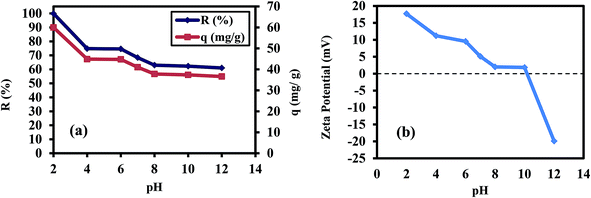 | ||
| Fig. 1 (a) R% and q vs. pH for 25 mL Cr(VI) solution (60 mg L−1) mixed with 1 g L−1 PANI/Ag (AMPSA)/GO QDs NC after 60 min at 30 °C and (b) zeta potential of PANI/Ag (AMPSA)/GO QDs NC vs. pH. | ||
With an increase in the pH of the solution, HCrO4− was gradually converted to other ion forms such as CrO42− and Cr2O72−. At a higher pH value, the competition between the negatively charged OH− ions in the adsorption medium and CrO42− species for the adsorbent sites caused a decrease in the efficiency of the adsorbent for the removal of Cr(VI) ions.
To understand how electrostatic forces affect the Cr(VI) adsorption behavior under different pH values, the relation between the zeta potential of the PANI/Ag (AMPSA)/GO QDs NC and pH from 2 to 12 was investigated, as shown in Fig. 1b. The zeta potentials confirm the presence of surface charges on the PANI/Ag (AMPSA)/GO QDs, which decrease sharply with an increase in the pH value. It was observed that the isoelectric point of PANI/Ag (AMPSA)/GO QDs NC is at about pH 10.3. The maximum positive and negative charges of +17.7 and −19.9 mV were found at pH of 2 and 12, respectively. Therefore, at higher pH, the repulsion between anionic chromium spices with negative surface charges on the PANI/Ag (AMPSA)/GO QDs nanocomposite plays a major role in decreasing the adsorption efficiency.10,25,29–32 Although, the R of Cr(VI) from solution at pH 12 using PANI/Ag (AMPSA)/GO QDs NC is only 61%, this value is much higher than other adsorbents.28–30,33
| 2HCrO4− + 14H+ + 3PANI2+ → 2Cr3+ + 3PANI4+ + 8H2O | (5) |
The EDX analysis was used to investigate the mechanism of Cr(VI) removal from aqueous solution at pH 2 by the PANI/Ag (AMPSA)/GO QDs NC. The EDX spectra obtained for PANI/Ag (AMPSA)/GO QD NC before and after Cr(VI) adsorption are shown in Fig. 2a and b, respectively. The EDX studies of PANI/Ag (AMPSA)/GO QDs NC showed a peak for silver. The presence of an Ag peak strongly indicates that Ag (AMPSA) NPs were successfully decorated on the PANI or PANI layer-coated Ag (AMPSA) NPs. Moreover, no Cr ions signals were observed in the EDX spectrum of PANI/Ag (AMPSA)/GO QDs before Cr(VI) adsorption (Fig. 2a). However, the EDX spectrum of the chromium-loaded PANI/Ag (AMPSA)/GO QDs NC indicates the adsorption of Cr(VI) ions, as shown in Fig. 2b. According to the EDX results, the chromium content on the NC surface increased from 0 to 1.01 atomic%, while the S content was reduced after Cr(VI) adsorption from 3.94 to 2.27 atomic%. There is no doubt that this relative content of S and Cr is related to the release of S and the adsorption of Cr(VI) via the anion exchange process between Cr(VI) and –SO3− dopant ions on the NC surface during Cr(VI) adsorption, respectively.
The reduction of Cr(VI) to Cr(III) was confirmed by analyzing the total Cr and Cr(VI) ions in solution with pH 2 containing 60 mg L−1 Cr(VI) after the adsorption process with 1 g L−1 of PANI/Ag (AMPSA)/GO QDs NC using ICP (CIROS VISION, Germany) and UV-vis spectrophotometry. The concentrations of total Cr and Cr(VI) ions were found to be 29.80 mg L−1 and 0.04 mg L−1, respectively. Subsequently, the estimated concentration of Cr(III) ions was determined to be 29.76 mg L−1. The adsorbed amount of Cr(VI) is about 30.24 mg L−1. These results confirm the proposed mechanism of the removal process of Cr(VI) by the PANI/Ag (AMPSA)/GO QDs NC.
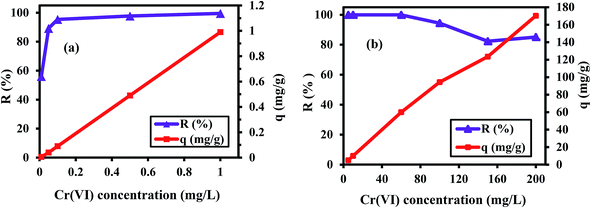 | ||
| Fig. 4 R% and q vs. Cr(VI) concentration ranging from 0.01 to 1 mg L−1 (a) and from 5 to 200 mg L−1 (b) at pH 2 and 30 °C after 60 min. | ||
The q values shown in Fig. 4a and b are found to linearly increase from 0.01 to 170.23 mg g−1 with an increase in the concentration of Cr(VI) from 0.01 to 200 mg L−1. Increasing the concentration of Cr(VI) provides a driving force to overcome the mass transfer resistance of the metal ions between the aqueous and solid phases, and this results in a higher probability of collision between the Cr(VI) ions and sorbent.42–44
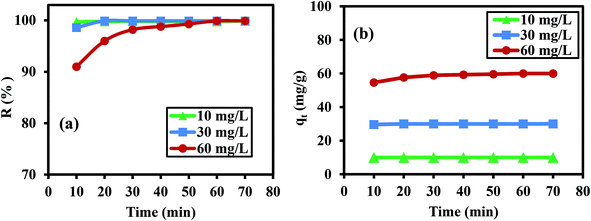 | ||
| Fig. 5 R (a) and qt (b) vs. contact time for different concentrations of Cr(VI) ions on 1 g L−1 PANI/Ag (AMPSA)/GO QDs NC at pH 2 and 30 °C. | ||
Fig. 5b displays the relationship between qt and contact time. Similarly, qt rapidly increased to a high value in a short time for 60 mg L−1 Cr(VI) and achieved 54.61 mg g−1 at 10 min. Then, it slightly increased with time until the adsorption capacity of 59.97 mg g−1 was obtained at 60 min. The rapid Cr(VI) adsorption can be attributed to the abundant adsorption sites on the surface of the adsorbent and the significant concentration drop between the liquid and solid phases in the initial stage, which led to the easy capture of Cr(VI) by the adsorbent in the solution. As the adsorption sites became covered and the concentration difference declined, it became difficult for Cr(VI) to capture the remaining sorption sites. This result is attributed to the repellency between the Cr(VI) ions in the solid and liquid phases, resulting in a lower adsorption rate until equilibrium is reached.32,45 The highest capacities (qe) for 10 and 30 mg L−1 Cr(VI) of 9.99 and 29.98 mg L−1 were achieved at 10 and 20 min, respectively.
The mechanism of Cr(VI) adsorption on the PANI/Ag (AMPSA)/GO QDs NC was investigated using the pseudo-first and pseudo-second order models. The linear form of the pseudo-first order kinetic model (Lagergren, 1898)46 is shown in eqn (6):
 | (6) |
By plotting log(qe − qt) versus t, the constant k1 (min−1) and qe (mg g−1) were determined from the slope and intercept of the obtained line, respectively.
The pseudo-second-order model (Ho and McKay, 1998)47 assumes that the adsorption of an adsorbate onto the adsorbent supports second order chemisorption. The pseudo-second order equation is represented with eqn (7):47
 | (7) |
Fig. 6a and b show the kinetic data fitting to the pseudo-first order and pseudo-second order kinetic models, respectively. Table 1 presents the rate constants and other parameters obtained from the linear regression. For the pseudo-first order kinetics fitting, the determination coefficient (R2) values are less than 1 for the 10 and 30 mg L−1 Cr(VI) solutions, and the estimated qe values of 0.02, 0.11 and 9.66 mg g−1 are less than that observed from the experiments (9.99, 29.98, and 59.97 mg g−1) for 10, 30 and 60 mg L−1 Cr(VI) solution, respectively. This indicates that Cr(VI) adsorption on the PANI/Ag (AMPSA)/GO QDs NC does not follow pseudo-first order kinetics. On the other hand, it was found that the R2 values obtained by applying the pseudo-second order model are about 1. The estimated qe values are consistent with that obtained experimentally in the case of the pseudo-second order model (9.99, 30.03 and 60.97 mg g−1) in 10, 30 and 60 mg L−1 Cr(VI) solution, respectively. The k2 values decreased with an increase in the Cr(VI) concentration, suggesting that rate of Cr(VI) adsorption on PANI/Ag (AMPSA)/GO QDs NC increased as the Cr(VI) concentration decreased.33 These results confirm that Cr(VI) adsorption by the PANI/Ag (AMPSA)/GO QDs NC follows pseudo-second order kinetics and chemisorption (chemical interaction such as complexation and redox reaction) occurs.47
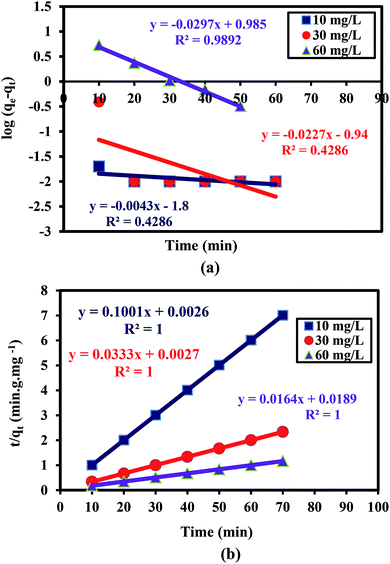 | ||
| Fig. 6 (a) Pseudo-first order and (b) pseudo-second order kinetic model plots of the adsorption of different concentrations of Cr(VI) ions on the PANI/Ag (AMPSA)/GO QDs NC at pH 2 and 30 °C. | ||
| Kinetic model | Initial Cr(VI) concentration | ||
|---|---|---|---|
| 10 mg L−1 | 30 mg L−1 | 60 mg L−1 | |
| Pseudo-first order | |||
| qe (mg g−1) | 0.02 | 0.11 | 9.66 |
| k1 (min−1) | 0.01 | 0.05 | 0.07 |
| R2 | 0.4286 | 0.4286 | 0.9892 |
![[thin space (1/6-em)]](https://www.rsc.org/images/entities/char_2009.gif) |
|||
| Pseudo-second order | |||
| qe (mg g−1) | 9.99 | 30.03 | 60.97 |
| k2 (g mg−1 min−1) | 3.85 | 0.41 | 0.01 |
| R2 | 1 | 1 | 1 |
| T (°C) | T (K) | 1/T (K−1) | k2 (g mg−1 min−1) | ln![[thin space (1/6-em)]](https://www.rsc.org/images/entities/char_2009.gif) k2 (mg L−1 min−1) k2 (mg L−1 min−1) |
|---|---|---|---|---|
| 22 | 295.15 | 0.0034 | 0.010 | −4.6 |
| 30 | 303.15 | 0.0033 | 0.016 | −4.6 |
| 40 | 313.15 | 0.0032 | 0.017 | −4.0 |
| 50 | 323.15 | 0.0031 | 0.033 | −3.4 |
| 60 | 333.15 | 0.0030 | 0.049 | −3.0 |
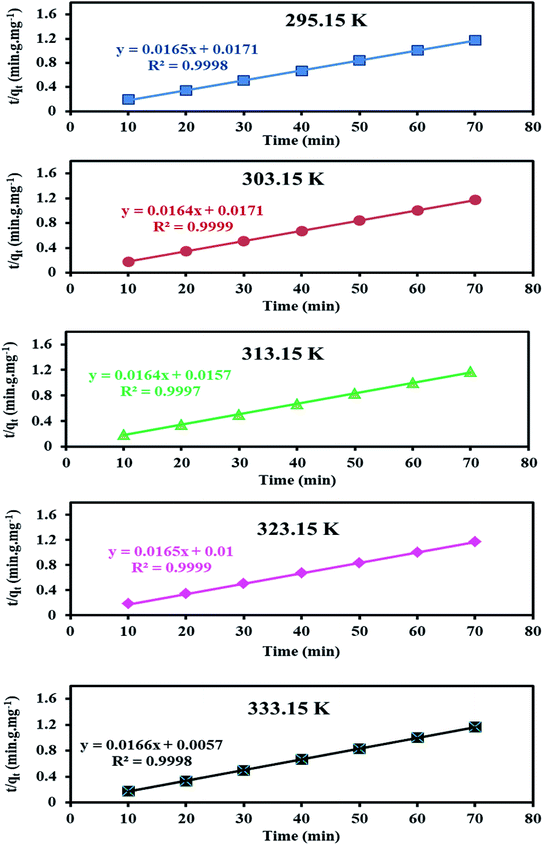 | ||
| Fig. 8 Pseudo-second order kinetic model plots for the adsorption of 60 mg L−1 Cr(VI) on the PANI/Ag (AMPSA)/GO QDs NC at different temperatures and pH 2. | ||
By applying Arrhenius eqn (8),33 the activation energy (Ea, kJ mol−1) for the adsorption of Cr(VI) on the surface of the PANI/Ag (AMPSA)/GO QDs NC was obtained from the slope of the plot of ln![[thin space (1/6-em)]](https://www.rsc.org/images/entities/char_2009.gif) k2 against 1/T (K−1) (Fig. 9).
k2 against 1/T (K−1) (Fig. 9).
 | (8) |
Ea was estimated to be 32.4 kJ mol−1, suggesting the chemisorption mechanism occurred. Activated chemisorption means that the rate of removal varies with temperature according to a finite activation energy (between 8.4 and 83.7 kJ mol−1) in the Arrhenius equation.30,50
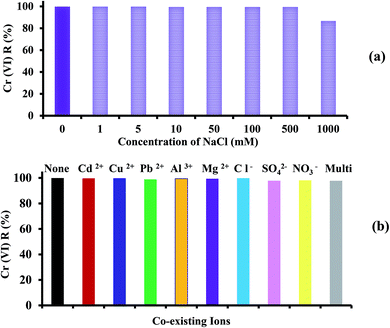 | ||
| Fig. 10 Effect of (a) ionic strength and (b) co-existing ions on the removal of 60 mg L−1 Cr(VI) by 1 g L−1 PANI/Ag (AMPSA)/GO QDs NC at pH 2 and 30 °C after 60 min. | ||
Industrial wastewater also contains other types of heavy metal cations and anions such as Cd(II), Cu(II), Pb(II), Al(III) and Mg(II). Therefore, it is essential to investigate the competitive influence of these co-existing ions on the Cr(VI) removal percentage using the PANI/Ag (AMPSA)/GO QDs nanocomposite. Initially, the Cr(VI) removal was recorded using 25 mL of 60 mg L−1 of Cr(VI) solution with 25 mg (1 g L−1) of PANI/Ag (AMPSA)/GO QDs NC. The effect of metal cations with individual concentrations of 60 mg L−1 on the Cr(VI) removal was studied, as shown in Fig. 10b. It was noted that the presence of 60 mg L−1 initial concentration of individual cations in solution did not affect the removal of Cr(VI). These cations ions are repelled from the positively charged surface of the PANI/Ag (AMPSA)/GO QDs NC.12 In addition, Cr(VI) adsorption occurs through anion exchange with doped –SO3− ions, and therefore the nanocomposite has little or no affinity for the cation ions.33 Other anions salts may also compete with the removal of Cr(VI) ions on the PANI/Ag (AMPSA)/GO QDs NC available binding sites. In addition, three common coexisting salts, NaCl, K2SO4 and Ca(NO3)2, were chosen to study the effect of their anions on the removal of Cr(VI). The results are shown in Fig. 10b. NaCl, Ca(NO3)2 and K2SO4 barely influenced the removal of Cr(VI). The reason for this is that Cl− and NO3− are monovalent anions, and they would slightly compete for the adsorption sites of PANI/Ag (AMPSA)/GO QDs NC.51 Besides, these anions have low affinity ligands, which mostly form weak outer sphere complexes with the binding sites on the adsorbent.33 Even though SO42− is a multivalent anion possessing a similar structure as HCrO4− and can compete with Cr(VI), and form both inner and outer sphere complexes,33,51 it had a small effect on the removal of Cr(VI). This suggests that the high selectivity of the prepared PANI/Ag (AMPSA)/GO QDs NC for Cr(VI) may be due to its ability to reduce Cr(VI) ions to Cr(III).52,53 Because of the partial reduction of Cr(VI) to Cr(III) by the PANI/Ag (AMPSA)/GO QDs NC, the equilibrium (eqn (5)) is shifted in the forward direction, which promotes the further adsorption and reduction of Cr(VI).
It was also found that presence of 60 mg L−1 of Cr(VI) with multi ions did not significantly affect the removal percentage by PANI/Ag (AMPSA)/GO QDs NC.
| Adsorbent (1 g L−1) | R (%) | q (mg g−1) |
|---|---|---|
| GO QDs | 77.7 | 46.64 |
| Ag (AMPSA) NPs | 70.6 | 42.37 |
| PANI | 81.4 | 48.84 |
| PANI/Ag (AMPSA) | 83.9 | 50.39 |
| PANI/GO QDs | 84.2 | 50.49 |
| PANI/Ag (AMPSA)/GO QDs NC | 99.9 | 59.96 |
Pure GO QDs exhibit small values of R% and q of 77.7% and 46.64 mg g−1, respectively, for the adsorption of Cr(VI) through electrostatic interactions coupled with Cr(VI) reduction to Cr(III) and followed by Cr(III) complexation.48,54 At a low pH value of 2, the removal of Cr(VI) in the aqueous phase is faster since the negatively charged Cr(VI) species migrate to the positive surface of the GO QDs (protonated hydroxyl groups and carbonyl groups) with the help of electrostatic driving forces. Cr(VI) reduction to Cr(III) by contact with the electron–donor groups of GO QDs (OH− groups) occurs during the adsorption process and the reduced Cr(III) remains in the aqueous solution.48 However, the low Cr(VI) R% and q of GO QDs are attributed to the aggregation resulting from the strong van der Waals interactions and π–π stacking of the graphene oxide, which reduce the availability of effective sorption area, hence decreasing the overall metal removal and capacity.55
Ag (AMPSA) NPs produced small values of Cr(VI) R% and q of 70.6% and 42.37 mg g−1, respectively at pH 2. The removal of Cr(VI) using Ag (AMPSA) NPs is mainly related to the amide (–CONH) and sulfonyl (–SO3−) groups on the structure of AMPSA-capped Ag NPs.56 The combination of Cr(VI) reduction and chelation of Cr(III) by the electron donating nitrogen of the (–CONH) groups and the ion exchange between (–SO3−) and the HCrO4− ions is attributed for the removal of Cr(VI) by Ag (AMPSA) NPs. However, the small values of Cr(VI) R% and q are due to the aggregation of the Ag (AMPSA) NPs, which significantly decreases their high capacity.18
PANI presented moderate values of Cr(VI) R% and q of 81.4% and 48.84 mg g−1, respectively at pH 2. The enhancement in the Cr(VI) R and q values is due to the ion exchange between the dopant (–SO3−) and the HCrO4− ions as well as the surface adsorption and reduction by the electron donating groups on the polyaniline structure.
As expected, the PANI/Ag (AMPSA) and PANI/GO QDs nanocomposites exhibited Cr(VI) R% values of 83.9% and 84.2%, and q values of 50.49 and 50.39 mg g−1, respectively. These results are higher than that obtained for pure PANI due to the presence of the Ag NPs and GO QDs, which increase the adsorption surface area of the nanocomposites and consequently enhance the interaction with the Cr(VI) ions.57 The superior removal percentage and capacity of Cr(VI) by PANI/Ag (AMPSA)/GO QDs (99.9%, 59.96 mg g−1) among the adsorbents are attributed to the synergistic effect of PANI, Ag (AMPSA) NPs and GO QDs, which increases the accessible binding sites on the adsorbent surface.58
The adsorption capacity of PANI/Ag (AMPSA)/GO QDs NC was compared to that of other adsorbents reported in previous literature, as presented in Table 4.
| Adsorbent | pH | qm (mg g−1) | Reference |
|---|---|---|---|
| PANI/sawdust/polyethylene glycol | 2.0 | 3.20 | 59 |
| Reduced graphene oxide-montmorillonite nanocomposite | 2.0 | 12.86 | 60 |
| PANI/polygorskite | 5.5 | 16.45 | 61 |
| PANI/akaganéite | 2.2 | 17.36 | 19 |
| Activated carbon/micro-sized goethite | 5.6 | 27.20 | 62 |
| PANI/humic acid | 5.0 | 29.26 | 63 |
| Polypyrrole/titanium(IV) phosphate | 2.0 | 31.64 | 64 |
| PANI/multiwalled carbon nanotubes | 4.5 | 31.75 | 65 |
| PANI-coated ethyl celluloses | 1.0 | 38.76 | 66 |
| Kapok fiber/PANI | 4.5 | 44.05 | 67 |
| PANI/magnetite | 7.6 | 54.00 | 68 |
| PANI/multiwalled carbon nanotubes | 2.0 | 55.55 | 69 |
| Hierarchical PANI–polystyrene | 4.0 | 58.00 | 70 |
| PANI/Ag (AMPSA)/GO QDs | 2.0 | 59.96 | Present study |
| Sample | Cr(VI) (mg L−1) | Cr(VI) spiked (mg L−1) | Cr(VI) found (mg L−1) | R% |
|---|---|---|---|---|
| a N.D.: not detected. | ||||
| Tap water | N.D. | 60 mg L−1 | 0.1172 | 99.8 |
| Raw water | N.D. | 60 mg L−1 | 0.9323 | 98.4 |
| Number of cycles | Cr(VI) adsorption% | Cr(VI) desorption% |
|---|---|---|
| 1 | 99.9 | 0.6 |
| 2 | 99.8 | 0.9 |
| 3 | 99.7 | 1.4 |
4. Conclusions
In this work, a ternary polymer nanocomposite-based adsorbent, PANI/Ag (AMPSA)/GO QDs NC, was prepared for the removal of Cr(VI) from aqueous solution. The adsorbent was synthesized via the in situ chemical oxidative polymerization of aniline monomers in the presence of Ag (AMPSA) NPs and GO QDs. The results indicated that the removal efficiency of the PANI/Ag (AMPSA)/GO QDs NC was highly pH dependent, and 99.9% removal and 59.96 mg g−1 maximum adsorption capacity were obtained at pH 2.0, 60 mg L−1 of Cr(VI) and 1 g L−1 NC dose after 60 min. The EDX and ICP studies suggested that the removal of Cr(VI) by the PANI/Ag (AMPSA)/GO QDs NC occurred through ion exchange with the dopant –SO3− ions in the structure of the adsorbent and the subsequent reduction of Cr(VI) to Cr(III) by the PANI and GO QDs. The PANI/Ag (AMPSA)/GO QDs NC showed high selectivity for Cr(VI) in aqueous solution in the presence of other anions and cations. Cr(VI) adsorption by PANI/Ag (AMPSA)/GO QDs NC followed pseudo-second order kinetics. The activation energy for the adsorption process was estimated to be 32.4 kJ mol−1, suggesting the chemisorption of Cr(VI) by the PANI/Ag (AMPSA)/GO QDs NC. The PANI/Ag (AMPSA)/GO QDs NC could be used for three treatment cycles without any loss in its adsorption efficiency. Therefore, considering its exceptional adsorption of Cr(VI) ions, good biocompatible properties and ability for reuse, the PANI/Ag (AMPSA)/GO QDs NC will be an ideal cost-effective candidate in the environmental processing field.Conflicts of interest
There are no conflicts to declare.References
- A. V. Pawlisz, R. A. Kent, U. A. Schneider and C. Jefferson, Canadian water quality guidelines for chromium, Environ. Toxicol. Water Qual., 1997, 12, 185–193 CrossRef.
- L. Liu, Y. Xu, K. Wang, K. Li, L. Xu, J. Wange and J. Wang, Fabrication of a novel conductive ultrafiltration membrane and its application for electrochemical removal of hexavalent chromium, J. Membr. Sci., 2019, 584, 191–201 CrossRef CAS.
- G. Sandoval-Olvera, P. González-Muñoz, L. Palacio, A. Hernández, M. Ávila-Rodríguez and P. Prádanos, Ultrafiltration membranes modified by PSS deposition and plasma treatment for Cr(VI) removal, Sep. Purif. Technol., 2019, 210, 371–381 CrossRef.
- Z. Shao, C. Huang, Q. Wu, Y. Zhao, W. Xu, Y. Liu, J. Dang and H. Hou, Ion exchange collaborating coordination substitution: more efficient Cr(VI) removal performance of a water-stable CuII-MOF material, J. Hazard. Mater., 2019, 378, 120719 CrossRef CAS PubMed.
- F. Liu, W. Zhang, L. Tao, B. Hao and J. Zhang, Simultaneous photocatalytic redox removal of chromium(VI) and arsenic(III) by hydrothermal carbon-sphere@nano-Fe3O4, Environ. Sci.: Nano, 2019, 6, 9289–9297 Search PubMed.
- C. Zhu, F. Liu, L. Song, H. Jiang and A. Li, Magnetic Fe3O4@polyaniline nanocomposites with a tunable core–shell structure for ultrafast microwave-energy-driven reduction of Cr(VI), Environ. Sci.: Nano, 2018, 487, 5–22 Search PubMed.
- B. Xie, C. Shan, Z. Xu, X. Li, X. Zhang, J. Chen and B. Pan, One-step removal of Cr(VI) at alkaline pH by UV/sulfite process: reduction to Cr(III) and in situ Cr(III) precipitation, Chem. Eng. J., 2017, 308, 791–797 CrossRef CAS.
- X. Ou, X. Liu, W. Liu, W. Rong, J. Li and Z. Lin, Surface defects enhance the adsorption affinity and selectivity of Mg(OH)2 towards As(V) and Cr(VI) oxyanions: a combined theoretical and experimental study, Environ. Sci.: Nano, 2018, 5, 2570–2578 RSC.
- S. Bolisetty, M. Peydayesh and R. Mezzenga, Sustainable technologies for water purification from heavy metals: review and analysis, Chem. Soc. Rev., 2019, 48, 463–487 RSC.
- W. Liu, L. Yang, S. Xu, Y. Chen, B. Liu, Z. Li and C. Jiang, Efficient removal of hexavalent chromium from water by an adsorption–reduction mechanism with sandwiched nanocomposites, RSC Adv., 2018, 8, 15087–15093 RSC.
- B. Karimi and B. Ramezanzadeh, A comparative study on the effects of ultrathin Luminescent graphene oxide quantum dot (GO QD) and graphene oxide (GO) nanosheets on the interfacial interactions and mechanical properties of an epoxy composite, J. Colloid Interface Sci., 2017, 493, 62–76 CrossRef CAS PubMed.
- S. Kumar, C. Terashima, A. Fujishima, V. Krishnan and S. Pitchaimuthu, Photocatalytic degradation of organic pollutants in water using graphene oxide composite, in A new generation material graphene: applications in water technology, ed. M.Naushad, Springer, Cham, 2019, pp. 413–438 Search PubMed.
- F. Ostovar, R. Ansari and H. F. Moafi, Preparation and application of silver oxide/sawdust nanocomposite for chromium (VI) ion removal from aqueous solutions using column system, Global NEST J., 2017, 19, 412–422 CAS.
- P. Xu, C. Cen, N. Chen, H. Lin, Q. Wang, N. Xu, J. Tang and Z. Teng, Facile fabrication of silver nanoparticles deposited cellulose microfiber nanocomposites for catalytic application, J. Colloid Interface Sci., 2018, 526, 194–200 CrossRef CAS PubMed.
- H. A. Ewais and A. Y. Obaid, Adsorption characteristics of toxic chromium(VI) from aqueous media onto nanosized silver nanoparticles-treated activated carbon, Sep. Sci. Technol., 2019, 54, 494–506 CrossRef CAS.
- C. Chen, K. Zhu, K. Chen, A. Alsaed and T. Hayat, Synthesis of Ag nanoparticles reduction of Cr(VI), J. Colloid Interface Sci., 2018, 526, 1–8 CrossRef CAS PubMed.
- S. Nayak and K. M. Parida, Dynamics of charge-transfer behavior in a plasmon-induced quasi-type-II p–n/n–n Dual Heterojunction in Ag@Ag3PO4/g-C3N4/NiFe LDH nanocomposites for photocatalytic Cr(VI) reduction and phenol oxidation, ACS Omega, 2018, 3, 7324–7343 CrossRef CAS PubMed.
- Y. Huang, J. Li, X. Chend and X. Wang, Applications of conjugated polymer based composites in wastewater purification, RSC Adv., 2014, 4, 62160–62178 RSC.
- S. Ebrahim, A. Shokry, H. Ibrahim and M. Soliman, Polyaniline/akaganéite nanocomposite for detoxification of noxious Cr(VI) from aquatic environment, J. Polym. Res., 2016, 23, 79–89 CrossRef.
- M. Bhaumik, K. V. Gupta and A. Maity, Synergetic enhancement of Cr(VI) removal from aqueous solutions using polyaniline/Ni(OH)2 nanocomposites adsorbent, J. Environ. Chem. Eng., 2018, 6, 2514–2527 CrossRef CAS.
- S. M. Ebrahim, M. M. Abd El Latif and M. M. Soliman, Blend of nylon 6 and polyaniline doped with sulfanilic acid and its schottky diode, High Perform. Polym., 2010, 22, 377–391 CrossRef CAS.
- S. Ebrahim, M. Soliman, M. Anas, M. Hafez and T. M. Abdel-Fattah, Dye-sensitized solar cell based on polyaniline/multiwalled carbon nanotubes counter electrode, Int. J. Photoenergy, 2013, 1–6 CrossRef.
- A. Shokry, M. M. A. Khalil, H. Ibrahim, M. Soliman and S. Ebrahim, Highly luminescent ternary nanocomposite of polyaniline, silver nanoparticles and graphene oxide quantum dots, Sci. Rep., 2019, 9, 16984 CrossRef PubMed.
- J. Zhu, S. Wei, H. Gu, S. B. Rapole, Q. Wang, Z. Luo, N. Haldolaarachchig, D. P. Young and Z. Guo, One-pot synthesis of magnetic graphene nanocomposites decorated with Core/double-shell nanoparticles for fast chromium removal, Environ. Sci. Technol., 2012, 46, 977–985 CrossRef CAS PubMed.
- O. U. Aigbe, R. Das, H. W. Ho, V. Srinivasu and A. Maity, A novel method for removal of Cr(VI) using polypyrrole magnetic nanocomposite in the presence of unsteady magnetic fields, Sep. Purif. Technol., 2018, 194, 377–387 CrossRef.
- R. Li, L. Liu and F. Yang, Preparation of polyaniline/reduced graphene oxide nanocomposite and its application in adsorption of aqueous Hg(II), Chem. Eng. J., 2013, 229, 460–468 CrossRef CAS.
- M. Pourbaix, Atlas of electrochemical equilibria in aqueous solutions, NAC, Houston, TX, 2nd edn, 1974, pp. 257–260 Search PubMed.
- T. Zhou, C. Li, H. Jin, Y. Lian and W. Han, Effective adsorption/reduction of Cr(VI) oxyanion by halloysite/polyaniline hybrid nanotubes, ACS Appl. Mater. Interfaces, 2017, 9, 6030–6043 CrossRef CAS PubMed.
- W. Fang, X. Jiang, H. Luo and J. Geng, Synthesis of graphene/SiO2/polypyrrole nanocomposites and their application for Cr(VI) removal in aqueous solution, Chemosphere, 2018, 197, 594–602 CrossRef CAS PubMed.
- H. N. Kera, M. Bhaumik, K. Pillay, S. S. Ray and A. Maity, m-Phenylenediamine-modified polypyrrole as an efficient adsorbent for removal of highly toxic hexavalent chromium in water, Mater. Today Commun., 2018, 15, 153–164 CrossRef.
- L. Jin, L. Huang, L. Ren, Y. He, J. Tang, S. Wang, W. Yang, H. Wang and L. Chai, Preparation of stable and high-efficient poly (m-phenylenediamine)/reduced graphene oxide composites for hexavalent chromium removal, ýJ. Mater. Sci, 2019, 54, 383–395 CrossRef CAS.
- H. N. Kera, M. Bhaumik, K. Pillay, S. S. Ray and A. Maity, Selective removal of toxic Cr(VI) from aqueous solution by adsorption combined with reduction at a magnetic nanocomposite surface, J. Colloid Interface Sci., 2017, 503, 214–228 CrossRef PubMed.
- M. S. Samuel, V. Subramaniyan, J. Bhattacharya, C. Parthiban, S. Chand and N. D. P. Singh, A GO-CS/MOF [Zn (BDC) (DMF)] material for the adsorption of chromium(VI) ions from aqueous solution, Composites, Part B, 2018, 152, 116–125 CrossRef CAS.
- K. L. Dilip and V. Chandra, Polyaniline functionalized graphene sheets for treatment of toxic hexavalent chromium, J. Environ. Chem. Eng., 2016, 4, 3006–3012 CrossRef.
- H. Gu, S. B. Rapole, J. Sharma, Y. Huang, D. Cao, H. A. Colorado, Z. Luo, N. Haldolaarachchige, D. P. Young, B. Walters, S. Wei and Z. Guo, Magnetic polyaniline nanocomposites toward toxic hexavalent chromium removal, RSC Adv., 2012, 2, 11007–11018 RSC.
- L. Tang, Y. Fang, Y. Pang, G. Zeng, J. Wang, Y. Zhou, Y. Deng, G. Yang, Y. Cai and J. Chen, Synergistic adsorption and reduction of hexavalent chromium using highly uniform polyaniline-magnetic mesoporous silica composite, Chem. Eng. J., 2014, 254, 302–312 CrossRef CAS.
- X. Xu, Q. Yu, Z. Lv, J. Song and M. He, Synthesis of high-surface-area rod-like alumina materials with enhanced Cr(VI) removal efficiency, Microporous Mesoporous Mater., 2018, 262, 140–147 CrossRef CAS.
- C. Yao, Y. Xu, Y. Kong, W. Liu, W. Wang, Z. Wang, Y. Wang and J. Ji, Polypyrrole/palygorskite nanocomposite: a new chromate collector, Appl. Clay Sci., 2012, 67–68, 32–35 CrossRef CAS.
- Y. Zhang, L. Xu, L. Zhao, J. Peng, C. Li, J. Li and M. Zhai, Radiation synthesis and Cr(VI) removal of cellulose microsphere adsorbent, ýCarbohydr. Polym., 2012, 88, 931–938 CrossRef CAS.
- S. Pandey and S. B. Mishra, Organic–inorganic hybrid of chitosan/organoclay bionanocomposites for hexavalent chromium uptake, ýJ. Colloid. Interface Sci., 2011, 361, 509–520 CrossRef CAS PubMed.
- K. K. Krishnani, S. Srinives, B. C. Mohapatra, V. M. Boddu, J. Hao, X. Meng and A. Mulchandani, Hexavalent chromium removal mechanism using conducting polymers, J. Hazard. Mater., 2013, 252–253, 99–106 CrossRef CAS PubMed.
- N. H. Mthombeni, M. S. Onyango and O. Aoyi, Adsorption of hexavalent chromium onto magnetic natural zeolite-polymer composite, J. Taiwan Inst. Chem. Eng., 2015, 50, 242–251 CrossRef CAS.
- X. Wang, J. Lu, B. Cao, X. Liu, Z. Lin, C. Yang, R. Su, X. Wu and X. Wang, Facile synthesis of recycling Fe3O4/graphene adsorbents with potassium humate for Cr(VI) removal, Colloids Surf., A, 2019, 560, 384–392 CrossRef CAS.
- R. Kumar, O. M. Ansari, A. Alshahrie, R. Darwesh, N. Parveen, K. S. Yadav, M. A. Barakat and H. M. Cho, Adsorption modeling and mechanistic insight of hazardous chromium on para toluene sulfonic acid immobilized-polyaniline/CNTs nanocomposites, J. Saudi Chem. Soc., 2019, 23, 188–197 CrossRef CAS.
- Z. Zhang, T. Gao, S. Si, Q. Liu, Y. Wu and G. Zhou, One-pot preparation of P(TA-TEPA)-PAM-RGO ternary composite for high efficient Cr(VI) removal from aqueous solution, Chem. Eng. J., 2018, 343, 207–216 CrossRef CAS.
- S. Lagergren, About the theory of so-called adsorption of soluble substances, K. Sven. Vetenskapsakad. Handl., 1898, 24, 1–39 Search PubMed.
- Y. S. Ho and G. McKay, The kinetics of sorption of basic dyes from aqueous solution by sphagnum moss peat, The Canadian Journal of Chemical Engineering, 1998, 76, 822–827 CrossRef CAS.
- M.-G. Shang, Y.-G. Liu, S.-B. Liu, G.-M. Zeng, X.-F. Tan, L.-H. Jiang, X.-X. Huang, Y. Ding, Y.-M. Guod and S.-F. Wang, A novel graphene oxide coated biochar composite: synthesis, characterization and application for Cr(VI) removal, RSC Adv., 2016, 6, 85202–85212 RSC.
- H. Jabeen, V. Chandra, S. Jung, W. J. Lee, S. K. Kim and B. S. Kim, Enhanced Cr (VI) removal using iron nanoparticle decorated grapheme, Nanoscale, 2011, 3, 3583–3585 RSC.
- Thermodynamics, ed. M. Tadashi, Intech Open, 2011, DOI:10.5772/13474.
- L. Tang, G.-D. Yang, G.-M. Zeng, Y. Cai, S.-S. Li, Y.-Y. Zhou, Y. Pang, Y.-Y. Liu, Y. Zhang and B. Luna, Synergistic effect of iron doped ordered mesoporous carbon on adsorption-coupled reduction of hexavalent chromium and the relative mechanism study, Chem. Eng. J., 2014, 239, 114–122 CrossRef CAS.
- B. Olad and R. Nabavi, Application of polyaniline for the reduction of toxic Cr(VI) in water, J. Hazard. Mater., 2007, 147, 845–851 CrossRef PubMed.
- K. Z. Setshedi, M. Bhaumik, S. Songwane, M. S. Onyango and A. Maity, Exfoliated polypyrrole-organically modified montmorillonite clay nanocomposite as a potential adsorbent for Cr(VI) removal, Chem. Eng. J., 2013, 222, 186–197 CrossRef CAS.
- P. Janik, B. Zawisza, E. Talik and R. Sitko, Selective adsorption and determination of hexavalent chromium ions using graphene oxide modified with amino silanes, Microchim. Acta, 2018, 185, 117–125 CrossRef PubMed.
- V. P. Chauke, A. Maity and A. Chetty, High-performance towards removal of toxic hexavalent chromium from aqueous solution using graphene oxide-alpha cyclodextrin-polypyrrole nanocomposites, J. Mol. Liq., 2015, 211, 71–77 CrossRef CAS.
- A. M. Atta, H. S. Ismail, H. M. Mohamed and Z. M. Mohamed, Acrylonitrile/acrylamidoxime/2-acrylamido-2- methylpropane sulfonic acid-based hydrogels: synthesis, characterization and their application in the removal of heavy metals, J. Appl. Polym. Sci., 2011, 122, 999–1011 CrossRef CAS.
- M. A. Salem, R. G. Elsharkawy and M. F. Hablas, Adsorption of brilliant green dye by polyaniline/silver nanocomposite: kinetic, equilibrium, and thermodynamic studies, Eur. Polym. J., 2016, 75, 577–590 CrossRef CAS.
- R. Li, L. Liu and F. Yang, Preparation of polyaniline/reduced graphene oxide nanocomposite and its application in adsorption of aqueous Hg(II), Chem. Eng. J., 2013, 229, 460–468 CrossRef CAS.
- M. R. Samani and D. J. Toghraie, Removal of hexavalent chromium from water using polyaniline/wood sawdust/poly ethylene glycol composite: an experimental study, J. Environ. Health Sci. Eng., 2019, 17, 53–62 CrossRef PubMed.
- Z. Zhang, H. Luo, X. Jiang, Z. Jiang and C. Yang, Synthesis of reduced graphene oxide-montmorillonite nanocomposite and its application in hexavalent chromium removal from aqueous solutions, RSC Adv., 2015, 5, 47408–47417 RSC.
- J. Wang, X. Han, Y. Ji and H. Ma, Adsorption of Cr(VI) from aqueous solution onto short-chain polyaniline/palygorskite composites, Desalin. Water Treat., 2015, 56, 356–365 CrossRef CAS.
- M. Su, Y. Fang, B. Li, W. Yin, J. Gu, H. Liang, P. Li and J. Wu, Enhanced hexavalent chromium removal by activated carbon modified with micro-sized goethite using a facile impregnation method, Sci. Total Environ., 2019, 647, 47–56 CrossRef CAS PubMed.
- Q. Li, L. Sun, Y. Zhang, Y. Qian and J. P. Zhai, Characteristics of equilibrium, kinetics studies for adsorption of Hg(II) and Cr(VI) by polyaniline/humic acid composite, Desalination, 2011, 266, 188–194 CrossRef CAS.
- U. Baig, R. A. K. Rao, A. A. Khan, M. M. Sanagi and M. A. Gondal, Removal of carcinogenic hexavalent chromium from aqueous solutions using newly synthesized and characterized polypyrrole–titanium(IV) phosphate nanocomposite, Chem. Eng. J., 2015, 280, 494–504 CrossRef CAS.
- J. H. Wang, X. L. Yin, W. Tang and H. R. Ma, Combined adsorption and reduction of Cr(VI) from aqueous solution on polyaniline/multiwalled carbon nanotubes composite, Korean J. Chem. Eng., 2015, 32, 1889–1895 CrossRef CAS.
- B. Qiu, C. Xu, D. Sun, H. Yi, J. Guo, X. Zhang, H. Qu, M. Guerrero, X. Wang, N. Noel and Z. Luo, Polyaniline coated ethyl cellulose with improved hexavalent chromium removal, ACS Sustainable Chem. Eng., 2014, 2, 2070–2080 CrossRef CAS.
- Y. Zheng, W. B. Wang, D. J. Huang and A. Q. Wang, Kapok fiber oriented polyaniline nanofibers for efficient Cr(VI) removal, Chem. Eng. J., 2012, 191, 154–161 CrossRef CAS.
- M. Rezvani, A. A. Asgharinezhad, H. Ebrahimzadeh and N. Shekari, A polyaniline-magnetite nanocomposite as an anion exchange sorbent for solid-phase extraction of chromium(VI) ions, Microchim. Acta, 2014, 181, 1887–1895 CrossRef CAS.
- R. Kumar, M. O. Ansari and M. A. Barakat, DBSA doped polyaniline/multi-walled carbon nanotubes composite for high efficiency removal of Cr(VI) from aqueous solution, Chem. Eng. J., 2013, 228, 748–755 CrossRef CAS.
- J. J. Alcaraz-Espinoza, A. E. Chávez-Guajardo, J. C. Medina-Llamas, C. A. S. Andrade and C. P. de Melo, Hierarchical composite polyaniline – (electrospun polystyrene) fibers applied to heavy metal remediation, ACS Appl. Mater. Interfaces, 2015, 7, 7231–7240 CrossRef CAS PubMed.
| This journal is © The Royal Society of Chemistry 2019 |

